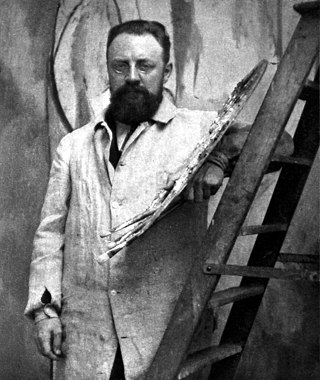
Henri Émile Benoît Matisse was a French visual artist, known for both his use of colour and his fluid and original draughtsmanship. He was a draughtsman, printmaker, and sculptor, but is known primarily as a painter. Matisse is commonly regarded, along with Pablo Picasso, as one of the artists who best helped to define the revolutionary developments in the visual arts throughout the opening decades of the twentieth century, responsible for significant developments in painting and sculpture.

Paul Victor Jules Signac was a French Neo-Impressionist painter who, with Georges Seurat, helped develop the artistic technique Pointillism.
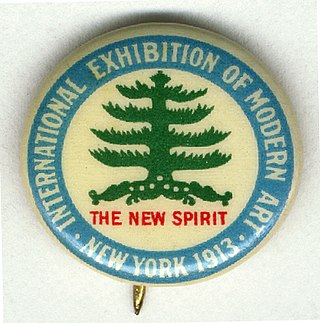
The 1913 Armory Show, also known as the International Exhibition of Modern Art, was organized by the Association of American Painters and Sculptors. It was the first large exhibition of modern art in America, as well as one of the many exhibitions that have been held in the vast spaces of U.S. National Guard armories.

Henri-Edmond Cross, born Henri-Edmond-Joseph Delacroix, was a French painter and printmaker. He is most acclaimed as a master of Neo-Impressionism and he played an important role in shaping the second phase of that movement. He was a significant influence on Henri Matisse and many other artists. His work was instrumental in the development of Fauvism.
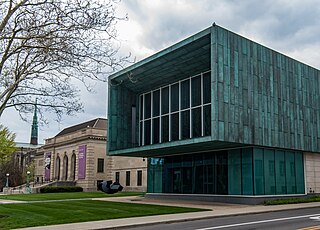
The Columbus Museum of Art (CMA) is an art museum in downtown Columbus, Ohio. Formed in 1878 as the Columbus Gallery of Fine Arts, it was the first art museum to register its charter with the state of Ohio. The museum collects and exhibits American and European modern and contemporary art, folk art, glass art, and photography. The museum has been led by Executive Director Brooke Minto since 2023.

TheBarnes Foundation is an art collection and educational institution promoting the appreciation of art and horticulture. Originally in Merion, the art collection moved in 2012 to a new building on Benjamin Franklin Parkway in Philadelphia, Pennsylvania. The arboretum of the Barnes Foundation remains in Merion, where it has been proposed that it be maintained under a long-term educational affiliation agreement with Saint Joseph's University.
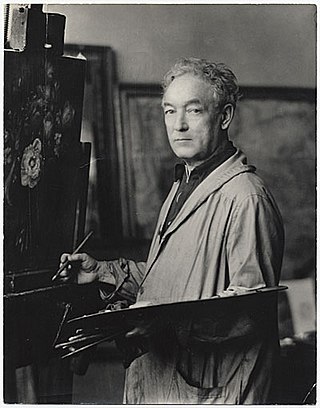
William James Glackens was an American realist painter and one of the founders of the Ashcan School, which rejected the formal boundaries of artistic beauty laid down by the conservative National Academy of Design. He is also known for his work in helping Albert C. Barnes to acquire the European paintings that form the nucleus of the famed Barnes Foundation in Philadelphia. His dark-hued, vibrantly painted street scenes and depictions of daily life in pre-WW I New York and Paris first established his reputation as a major artist. His later work was brighter in tone and showed the strong influence of Renoir. During much of his career as a painter, Glackens also worked as an illustrator for newspapers and magazines in Philadelphia and New York City.

Ellsworth Kelly was an American painter, sculptor, and printmaker associated with hard-edge painting, Color Field painting and minimalism. His works demonstrate unassuming techniques emphasizing line, color and form, similar to the work of John McLaughlin and Kenneth Noland. Kelly often employed bright colors. He lived and worked in Spencertown, New York.
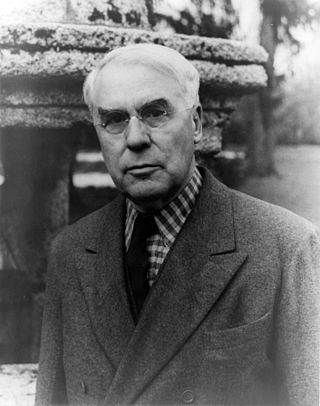
Albert Coombs Barnes was an American chemist, businessman, art collector, writer, and educator, and the founder of the Barnes Foundation in Philadelphia, Pennsylvania.

The Red Studio is an oil on canvas painting by French artist Henri Matisse from 1911. It is held in the collection of the Museum of Modern Art, in New York.
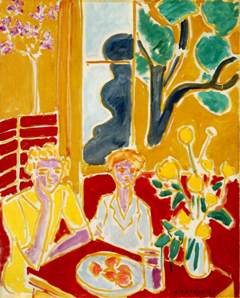
Deux fillettes, fond jaune et rouge (1947), oil on canvas, 61 x 49.8 cm is a painting by Henri Matisse in the collection of the Barnes Foundation, Merion, Pennsylvania.
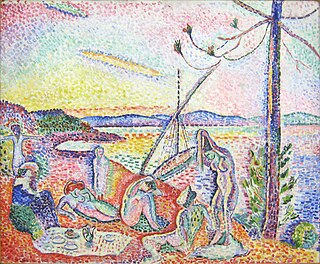
Luxe, Calme et Volupté is a 1904 oil painting by the French artist Henri Matisse. Both foundational in the oeuvre of Matisse and a pivotal work in the history of art, Luxe, Calme et Volupté is considered the starting point of Fauvism. This painting is a dynamic and vibrant work created early on in his career as a painter. It displays an evolution of the Neo-Impressionist style mixed with a new conceptual meaning based in fantasy and leisure that had not been seen in works before.

Fauvism is a style of painting and an art movement that emerged in France at the beginning of the 20th century. It was the style of les Fauves, a group of modern artists whose works emphasized painterly qualities and strong colour over the representational or realistic values retained by Impressionism. While Fauvism as a style began around 1904 and continued beyond 1910, the movement as such lasted only a few years, 1905–1908, and had three exhibitions. The leaders of the movement were André Derain and Henri Matisse.

Lizzie Plummer Bliss, known as Lillie P. Bliss, was an American art collector and patron. At the beginning of the 20th century, she was one of the leading collectors of modern art in New York. One of the lenders to the landmark Armory Show in 1913, she also contributed to other exhibitions concerned with raising public awareness of modern art. In 1929, she played an essential role in the founding of the Museum of Modern Art. After her death, 150 works of art from her collection served as a foundation to the museum and formed the basis of the in-house collection. These included works by artists such as Paul Cézanne, Georges Seurat, Paul Gauguin, Henri Matisse, Pablo Picasso and Amedeo Modigliani.
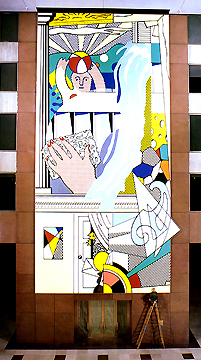
Mural with Blue Brushstroke is a 1986 mural painting by Roy Lichtenstein that is located in the atrium of the Equitable Tower in New York City. The mural was the subject of the book Roy Lichtenstein: Mural With Blue Brushstroke. The mural includes highlights of Lichtenstein's earlier works.

La danse is an oil painting created circa 1906 by the French artist and theorist Jean Metzinger (1883–1956). Bacchante is a pre-Cubist or Proto-Cubist work executed in a highly personal Divisionist style during the height of the Fauve period. Bacchante was painted in Paris at a time when Metzinger and Robert Delaunay painted portraits of one another, exhibiting together at the Salon d'Automne and the Berthe Weill gallery. Bacchante was exhibited in Paris during the spring of 1907 at the Salon des Indépendants, along with Coucher de soleil and four other works by Metzinger.
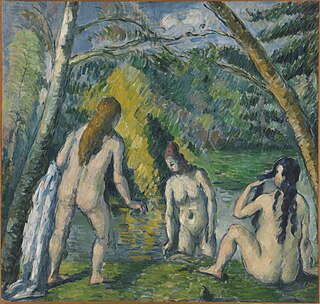
Three Bathers is an 1879-1882 oil-on-canvas painting by Paul Cézanne, which is housed in the Petit Palais in Paris. It shows three bathing female nudes framed in an arch formed by two trees. Executed in a typically Impressionist style with short heavy brushstrokes and strong colours, the painting displays notable pictorial composition and form.
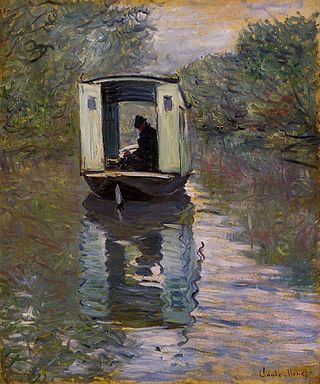
The Studio Boat is a painting from 1876 by the French Impressionist Claude Monet. The work depicts Monet at work in his studio boat on the Seine in Argentueil. It was executed en plein air in oil on canvas. It currently is in the collection of the Barnes Foundation of Philadelphia.

After the Bath is a painting from 1910 by the French painter Pierre-Auguste Renoir representing his late work period (1892–1919). The painting is now in the Barnes Foundation in Philadelphia.

French visual artist Henri Matisse was known for his use of color and draughtsmanship. In the early 20th century, Matisse became a leader of the Fauvism art movement, which was an early movement in the broader Post-impressionist era.





















